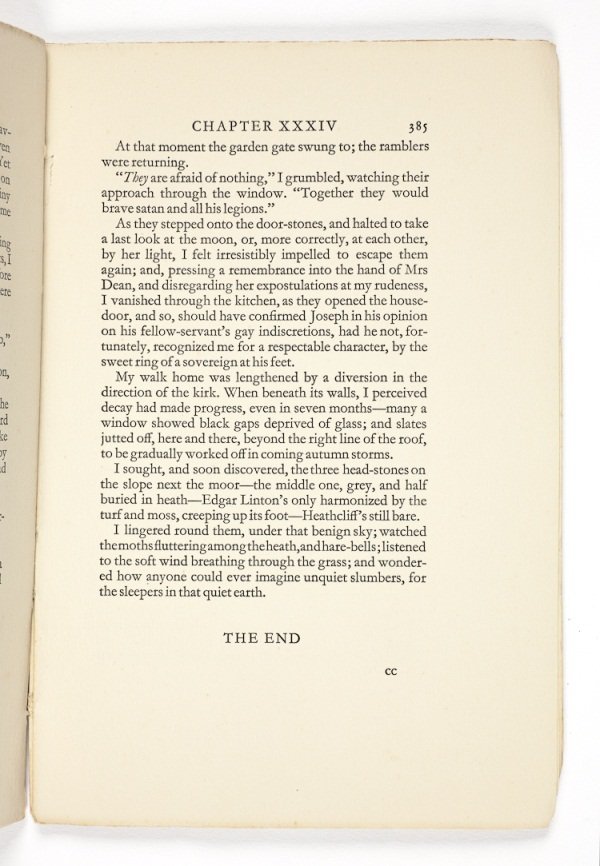
The Shakespeare Birthplace Trust’s library is a haven for literature of all kinds and among the First Folios and the early printed books there lurks another more modern literary treasure…
Stored inside an archival quality box, kept together with a pink piece of ribbon, lie several hundred unbound pages. On the first sheet of this crisp white pile, the neatly printed text spells out 'Wuthering Heights written by Ellis Bell' (Emily Brontë’s male pseudonym).
Published in 1931 by the Shakespeare Head Press, this edition of Wuthering Heights is an important part of Stratford-upon-Avon’s local history. At 21 Chapel Street (now, fittingly, a bookshop) there used to be the headquarters of the Shakespeare Head Printing Press. The founder, Elizabethan scholar A. H. Bullen, claimed the idea of setting up a printing-press in Stratford-upon-Avon came to him in a dream. In Bullen’s sleep-induced vision, he imagined a Stratford printing-press producing the complete works of William Shakespeare in the Bard’s town of origin.
In 1904 Bullen set out to make his dream come true, and began producing the plays of Shakespeare in hand-set type (including Hamlet). Sadly, others in the town did not share Bullen’s vision and the business failed to boom. After Bullen died in 1927, the press was bought in partnership. One of the new partners was the Oxford bookseller Basil Blackwell, who published the unbound edition of Wuthering Heights in 1931.

Difficult, disturbing, and full of dysfunctional family drama, Emily Brontë’s Wuthering Heights and William Shakespeare’s Hamlet share more than just a Stratford-upon-Avon printing press. Both of these literary triumphs are bleak depictions of relationships pushed to the brink of destruction (and beyond). First published in 1847, Brontë’s novel tells the disturbing tale of a defective family in provincial Yorkshire. Similarly, Hamlet is an incestuous tale of murder, madness and melancholy that shows the breakdown of family relations in the claustrophobic Danish court.
Both thematically and literally Wuthering Heights and Hamlet have one foot in the grave. In Hamlet we see Laertes jump into the open grave of his sister Ophelia, soon followed by her former lover Hamlet. In a striking literary parallel, in Wuthering Heights Heathcliff lays in the grave of his adopted sister come prospective lover Kathy. In both texts, Kathy and Ophelia are driven mad by patriarchal emotional abandonment. This leads them to tragic deaths - Ophelia’s drowning and Kathy’s abuse of her body during pregnancy. Then in melodramatic acts of remorse, sorrow, and (perhaps) perversion, Laertes, Hamlet and Heathcliff leap into the grave after Ophelia and Kathy.
The similarities between the two texts are striking to say the least, and it seems unlikely to be down to pure coincidence. It is known that the Brontë sisters read the works of Shakespeare while being home educated in their Yorkshire family residence. In fact, the Brontë sisters were privileged enough to study their Shakespeare from an extremely rare First Folio. This First Folio was housed at Ponden Hall (two miles across the moor from the sisters) which held one of early nineteenth century Europe's largest private library collections. Charlotte described Shakespeare with derision in her personal correspondence, but Emily and Anne were known to visit Ponden often to leaf through the Folio and other rare books. It then appears more than likely that Emily was directly influenced by the writings of Shakespeare.
The connections between William Shakespeare and Emily Brontë then are more than just a shared space in the Shakespeare Birthplace Trust’s Collection. Scratch the literary and historical surface of these two texts, and a multitude of comparisons come to the surface. Not only is there a shared printing history in Stratford-upon-Avon, but thematically and narratively they echo one another over the centuries. The grave scene is such an explicit literary parallel, it seems almost certain that Emily was influenced by Shakespeare’s writings.

